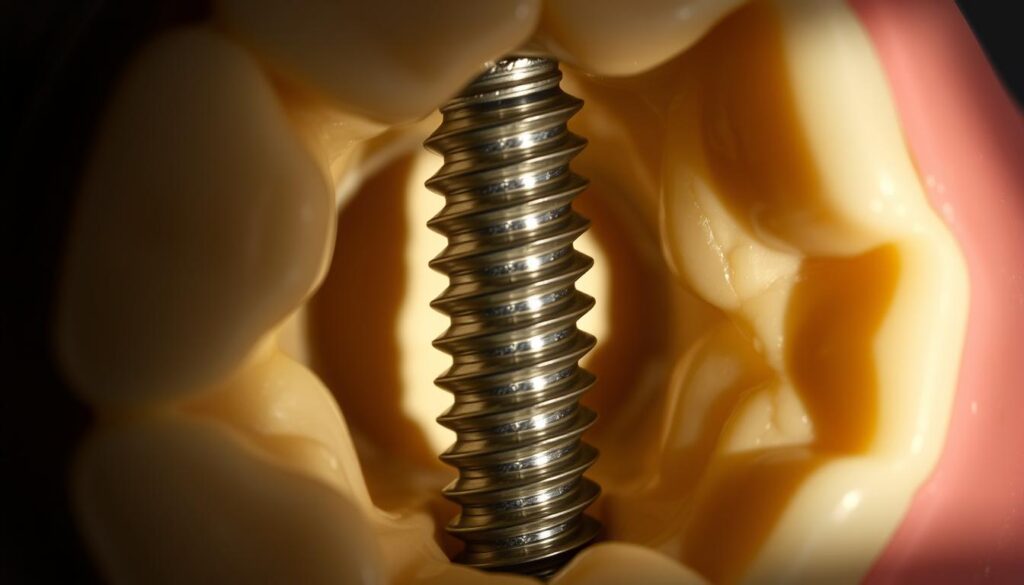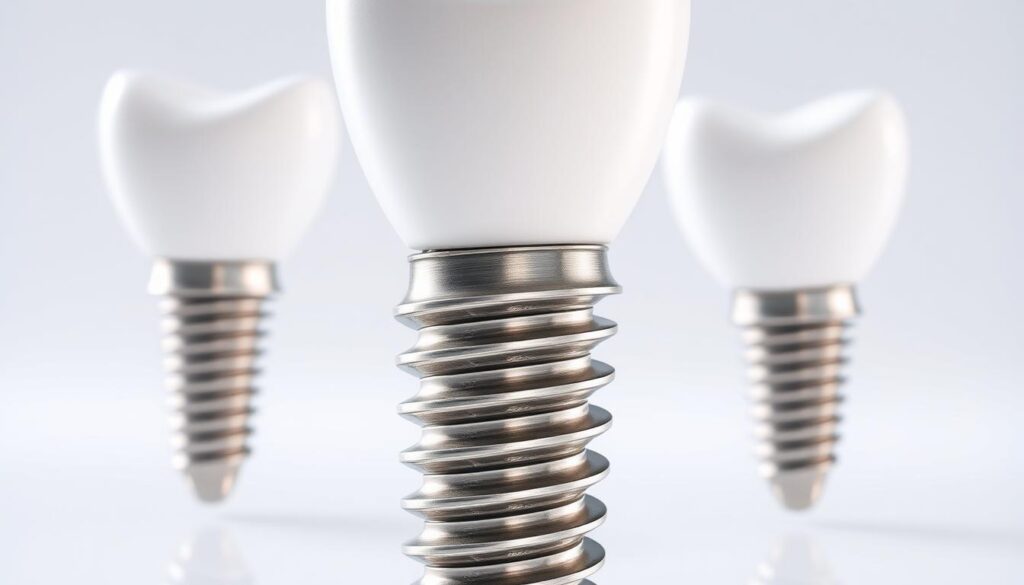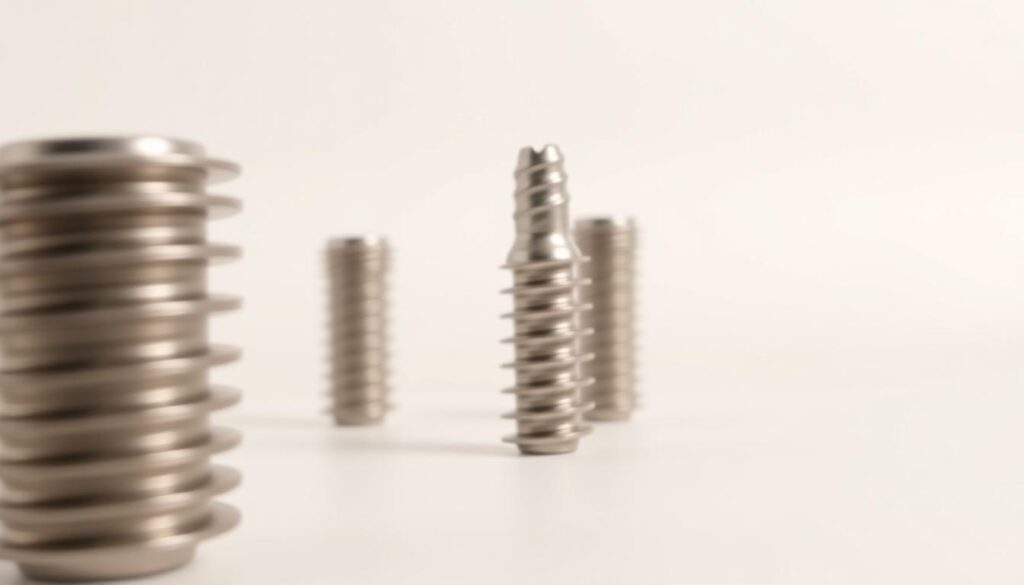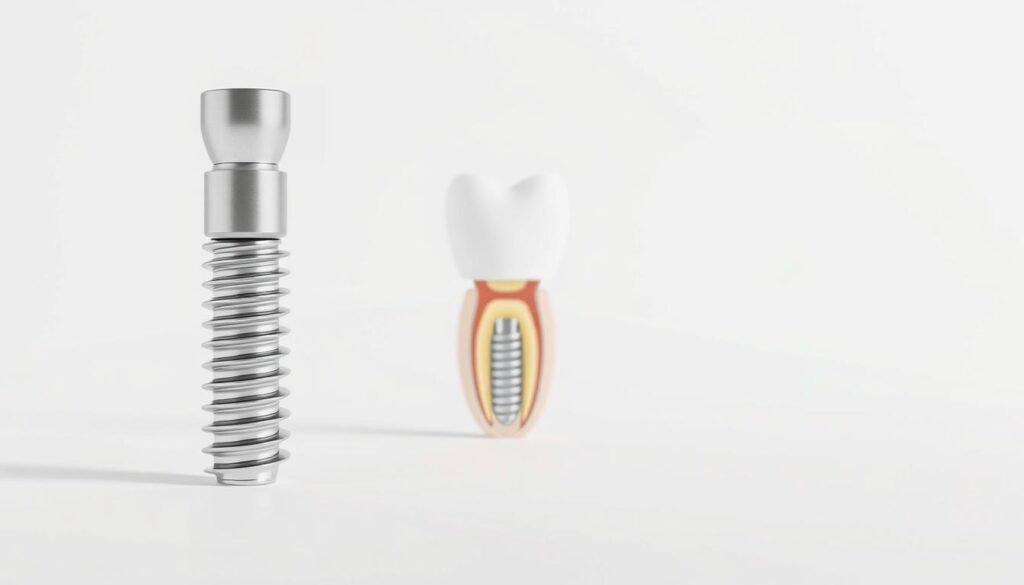Ever wondered what a dental implant looks like and how it fits with your natural teeth? Many people are curious about dental implants before deciding. This guide shows you what dental implants look like and how they’re made.
A dental implant has three main parts. The titanium post is like an artificial root under the gum. The abutment connects the post to the crown. The crown is the part you see when you smile. Each part is crucial for a natural look.
So, what does a dental implant look like? The crown, which is the visible part of the implant, is designed to closely resemble your natural teeth. It’s color-matched to your existing teeth and shaped to fit seamlessly in your smile. With advanced technology, the crown is made to replicate the size, shape, and texture of your real teeth.
Today’s dental implants are made to match your teeth perfectly. Dentists use advanced materials and methods for a perfect fit. The looks of dental implants have gotten much better. Now, most people can’t tell the difference between an implant and a real tooth.
Knowing what a dental implant looks like makes patients more confident. The materials used in implants blend well with your bone and gums. This makes the implant stable and natural-looking, even when you eat or speak.
Key Takeaways
- Dental implants have three main components: titanium post, abutment, and crown
- The crown is custom-made to match your natural teeth in color, size, and shape
- Modern implants use biocompatible materials that integrate with bone tissue
- Advanced technology ensures implants look and feel like natural teeth
- Each implant is precisely crafted to blend seamlessly with existing teeth
- The titanium post provides stable support as an artificial tooth root
Understanding Dental Implant Components
The dental implant structure has three key parts. They work together to replace a tooth. Each part is important for a natural-looking smile and lasting results. Knowing about these parts helps you see how implants work and why they’re the best choice for tooth replacement.
The Titanium Implant Post
The titanium post is the base of every dental implant. It acts as an artificial tooth root. This part is a screw-like cylinder, 3.5 to 6 millimeters wide and 8 to 16 millimeters long. It has special threads that hold onto the jawbone when it’s placed.
Titanium is perfect for this job because it bonds well with bone. This process, called osseointegration, makes the post stable for chewing for many years. After healing, the post is hidden under your gum line.

The Connecting Abutment
The abutment sits on top of the implant post. It connects the root to the crown. This small piece goes through the gum and holds the crown in place. Abutments come in different angles and heights to fit your mouth perfectly.
Knowing what does a dental implant look like before the crown shows how important the abutment is. It looks like a small metal post in the gums, waiting for the crown.
The Custom-Made Crown
The crown is the part of the dental implant you see. It’s made from porcelain or ceramic to look like a real tooth. Each crown is made to match your teeth in color, shape, and size. Modern crowns have layers that make them look like real teeth, blending in with your smile.
What Does a Dental Implant Look Like?
Dental implants look a lot like your own teeth. They are designed to match your smile perfectly. The crown part of the implant is visible and looks just like your teeth.
Visual Characteristics of the Complete Implant
A dental implant has three parts. The titanium post is hidden under the gum. The abutment connects to this post. The crown, which you see, is made to match your teeth.

How Implants Mimic Natural Teeth
Dental implants are made to look just like your teeth. They fit into your jawbone for a natural look. The crown has the right color, shape, and texture to blend in.
- Matching translucency levels
- Natural light reflection properties
- Proper size and contour
- Realistic surface texture
The Role of Porcelain and Ceramic Materials
Porcelain and ceramic make implants look real. They reflect light like natural teeth. Porcelain crowns can last up to ten years, keeping their natural look.
Types of Dental Implants Available
Dental implants come in different types, each for specific needs. Knowing these options helps both patients and dentists make the best choice. Each type has its own look and benefits for replacing teeth.
Traditional Dental Implants
Traditional endosteal implants are the most common. They are surgically placed in the jawbone for a stable base. These implants look like natural tooth roots, with a diameter of 3.5 to 6 millimeters. They are made of titanium and bond with bone through osseointegration.

Mini Dental Implants
Mini dental implants are smaller, less than 3 millimeters wide. They’re great for those with little bone or who want less invasive options. Their small size means quicker healing and sometimes immediate placement.
Immediate Loading Implants
Same-day implants let patients get temporary crowns right after. This cuts down treatment time and keeps the implants looking good. These implants have special designs for quick stability. Patients can leave with teeth the same day, but permanent ones come later.
The Dental Implant Structure Explained
Understanding the dental implant structure shows why these tooth replacements are so effective. Each part has a specific role. Together, they create a stable, functional tooth that can last for decades.
The base of every dental implant is a titanium post, acting as an artificial tooth root. This post is usually between 3 to 6 millimeters in diameter. Its length varies based on the bone density of the individual. The titanium material bonds with jawbone tissue, creating a strong foundation.

On top of the implant post is the abutment, a connector linking the root to the crown. Engineers design each abutment with precise angles and heights. This ensures comfortable chewing and a natural bite.
The crown is the visible part of what does a dental implant looks like in your mouth. The thickness of the crown depends on its location and the forces it will face. Front teeth need thinner crowns for looks, while molars require thicker ones for strength.
This three-part system spreads chewing forces like natural teeth do. The design also allows for easy replacement of parts if needed. This means dentists can often replace just one part, not the whole implant.
Dental Implant Aesthetics and Natural Appearance
Creating a dental implant that looks natural is all about the details. Modern implants are designed to match your real teeth perfectly. This ensures your smile looks confident and natural.
Color Matching Technology
Dentists use advanced tools to match your teeth’s color. They analyze your teeth under different lights. This helps pick the right shade from over 20 options.
Translucency and Light Reflection
Natural teeth let light through, making them look real. Modern implants use special porcelain to do the same. The crown’s texture reflects light like real teeth, blending with your smile.
Gum Line Integration
The way gum heals around an implant is key to its look. Dentists shape the gum to match your natural contours. They plan the crown’s edge to blend smoothly with your gum, making it look natural.
| Aesthetic Feature | Natural Teeth | Dental Implants |
|---|---|---|
| Color Variations | Multiple shades from root to tip | Customized gradient coloring |
| Light Transmission | Partial translucency | Matched translucency levels |
| Surface Texture | Natural enamel ridges | Replicated surface patterns |
| Gum Interface | Natural emergence | Sculpted emergence profile |
Visual Changes During the Placement Process
The look of dental implants changes in stages over months. Each step brings new looks until the final tooth looks real. Knowing these changes helps patients understand their journey.
Initial Surgical Placement
At first, the implant is hidden under the gum. Your surgeon makes a small hole in the jawbone and places the implant. The metal post is not seen.
The gum is closed over the implant. You might see swelling or a small bump. Some get a healing cap, a small silver button, under the gum.
Healing and Osseointegration Phase
This stage lasts three to six months. Bone cells grow around the implant, making it strong. This is called osseointegration.
Changes during healing include:
- Gum tissue reshapes around the implant
- Swelling goes down in days
- The area looks natural with the gums
- Temporary teeth may be used for looks
Final Crown Attachment
The last step is when the crown is attached. Your dentist puts on a custom-made crown. The crown looks like your natural teeth.
Size and Shape Customization
Every dental implant is made just for you, fitting your mouth perfectly. Your dentist takes exact measurements for your new tooth. This ensures your replacement tooth looks and feels like the one you lost.
The dental implant’s structure depends on several things. Your dentist looks at the bone width to pick the right implant size. The crown length is matched to your other teeth for a natural smile. Each detail is planned carefully for the best results.
Modern tech is key in making implants just right. Computer-aided design helps dentists plan every detail before surgery. This means your implant fits perfectly with your teeth.
| Customization Factor | Standard Range | Purpose |
|---|---|---|
| Implant Diameter | 3.0mm – 6.0mm | Matches tooth root size |
| Crown Height | 8mm – 12mm | Aligns with adjacent teeth |
| Abutment Angle | 0° – 30° | Corrects implant positioning |
| Crown Width | 5mm – 11mm | Fills tooth gap naturally |
When it comes to shape, your dentist aims to match your natural tooth’s curve. They pay close attention to how your new tooth will fit with others. Your face shape also plays a role in choosing the right size and angle for your tooth. The end result is a tooth that looks and feels just right in your mouth.
How Dental Implants Appear Inside the Mouth
Dental implants can make your smile look natural and complete. They blend in with your teeth perfectly. Knowing what a dental implant looks like inside your mouth shows the beauty of modern dentistry.
Blending with Surrounding Teeth
The look of dental implants depends on matching colors and shapes. Dental labs use special systems to match the crowns to your teeth. The crowns look and feel like real teeth, making them hard to spot.
Gum Tissue Adaptation
Healthy gums are key to a natural look. The gums form small areas around the implant, making it look like a real tooth. The crown’s edge fits perfectly with the gum, creating a natural look.
Bite Alignment and Spacing
Implants are placed carefully to look and feel right. They keep your teeth evenly spaced and prevent gaps. This ensures your bite feels balanced and natural.
| Alignment Feature | Visual Impact | Functional Benefit |
|---|---|---|
| Crown Height | Even smile line | Balanced bite force |
| Tooth Spacing | Natural gaps between teeth | Easy cleaning access |
| Midline Position | Symmetrical appearance | Proper jaw alignment |
Dental Implant Design Features
Modern dental implants use advanced engineering to offer both function and beauty. Each part is designed to work well with your bone and last for many years.
Key features include special surface treatments and connection systems. Titanium posts get micro-textured, creating tiny grooves and pores. This increases the surface area by up to 300%, helping bone cells attach better.
| Design Feature | Function | Patient Benefit |
|---|---|---|
| Micro-threads | Distribute bite forces evenly | Preserves surrounding bone |
| Platform Switching | Reduces bone loss at implant neck | Better gum aesthetics |
| Morse Taper Connection | Creates bacterial seal | Prevents infection |
| Anti-rotational Elements | Locks crown in place | No loose restorations |
The connection between the implant and crown is vital. Morse taper connections seal the parts together, stopping bacteria. This design cuts the risk of infection by up to 90% compared to older systems.
Modern implants also have angle correction features. These allow dentists to adjust for uneven bone. Angled abutments ensure the crown fits perfectly with your natural teeth.
Factors Affecting Final Implant Appearance
Many things decide what does a dental implant look like after treatment. Each person’s body and health are key to getting the best dental implant aesthetics. Knowing these factors helps patients know what to expect.
Facial Structure Considerations
Your face shape affects how big and where the implant goes. Jaw size helps pick the right crown angle for a natural look. People with bigger faces might need bigger crowns, while those with smaller features might do better with smaller ones.
Jawbone Density and Health
Strong jawbone support is crucial for the implant and gums. If the bone is too thin, a graft might be needed before the implant. This step helps the implant stay stable and look good.
Position in the Mouth
Replacing front teeth needs very careful planning. The implant must match the look of nearby teeth. Back teeth implants focus more on function than looks. But, implants in the front must look right, with the right shape and size.
Existing Teeth Characteristics
Your natural teeth are a guide for the implant design. Dentists look at:
- Color and undertones
- Wear from daily life
- Alignment and spacing
- Shape and size of each tooth
Healthy gums are essential for a good-looking implant. If the gums are thin or receding, extra treatments might be needed.
Materials That Create Natural-Looking Results
The success of dental implant appearance depends on the materials used. Each part needs materials that are strong and look good. Modern dentistry has made options that look and feel like real teeth but last longer.
Biocompatible Titanium Base
Titanium is the base for most dental implants. It fits well with jawbone tissue. The body usually accepts titanium without problems.
High-Grade Porcelain Crowns
Porcelain crowns are the top choice for dental implants. They are made to look like real teeth. The layers of porcelain give them depth and shine.
They reflect light like real teeth, making them hard to tell apart. They also resist stains from drinks like coffee and wine better than real teeth.
Advanced Ceramic Options
Zirconia and other ceramics are strong and look great. They offer:
- Natural white color throughout the entire crown
- Resistance to chips and cracks
- Excellent gum tissue compatibility
- Long-lasting color stability
| Material Type | Strength Rating | Aesthetic Quality | Typical Lifespan |
|---|---|---|---|
| Titanium Base | Excellent | Not visible | 25+ years |
| Porcelain Crown | Very Good | Excellent | 15-20 years |
| Zirconia Crown | Excellent | Very Good | 20-25 years |
Long-Term Visual Outcomes of Dental Implants
Investing in dental implants means you want them to look good for years. The good news is that dental implant aesthetics stay stable over time. With the right care, your implants will look natural for decades, boosting your smile confidence.
Implants are great because they keep your face looking good. Unlike dentures, implants help keep your jawbone strong. This stops your face from looking sunken, keeping your look youthful.
The crown of your implant wears down less than natural teeth. Modern materials keep their shape and color for years. Regular dental visits catch small problems early, keeping your dental implant appearance perfect. Cleanings also keep the gums healthy and pink around the implant.
| Timeframe | Visual Characteristics | Maintenance Needed |
|---|---|---|
| 1-5 years | Bright, natural color matching | Daily brushing and flossing |
| 5-10 years | Minimal wear, stable gum line | Biannual professional cleanings |
| 10-15 years | Consistent appearance, possible crown update | Annual checkups for crown condition |
| 15+ years | Continued natural look with proper care | Ongoing routine dental care |
Studies show that dental implants have a success rate of, lasting a lifetime. Their look stays great for years. Patients are happy with what does a dental implant look like even after 20 years.
Your daily habits are key to keeping implants looking good. Simple steps like:
- Brushing twice daily with a soft-bristled toothbrush
- Flossing around the implant crown
- Using an antimicrobial mouthwash
- Avoiding tobacco products
These habits keep the gums healthy and pink. Before and after photos from real patients show implants looking natural for years. The look stays consistent year after year.
Conclusion
When people ask “what does a dental implant look like?”, the answer shows how far dentistry has come. Today, dental implants have a three-part system for stable, beautiful teeth. The titanium post is strong, the abutment connects to a custom crown, and it all looks natural.
The look of dental implants depends on advanced materials and careful customization. Modern crowns are made of ceramic and porcelain, just like natural teeth. Dentists use special technology to match the color of your teeth, making the implant almost invisible.
For implants to last, you need to take good care of them and see your dentist regularly. With proper care, dental implants can last a lifetime. The crown might need to be replaced after 15-20 years. Talking to experts like Yes Dental PLLC or Gordon Dental Implants and Cosmetics can help you get the best results.
